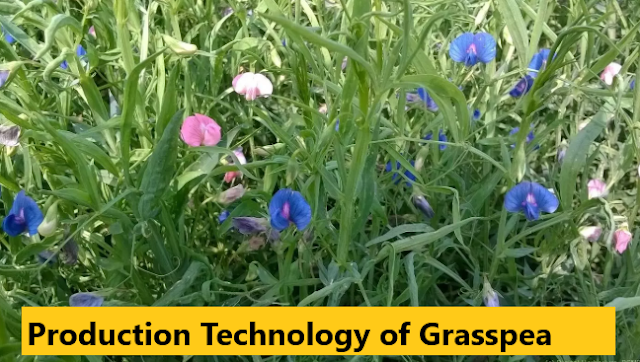New Update Production Technology of Grasspea
B.Sc.Ag. (Hons) Part-IV
 |
| Production Technology of Grasspea. https://cststudy.blogspot.com/ |
Production Technology of Grasspea
Scientific name: Lathyrus sativus L.
Family: Leguminosae.
Importance
Grass pea (Lathyrus sativus L.) is a crop of immense economic significance, especially in developing nations including India, Bangladesh, Pakistan, Nepal and Ethiopia. It serves a variety of purposes including food, feed and fodder, owing in part to its nutritive qualities. Prior to domestication, the crop was presumably present as a weed among other pulse crops.
Origin
The origin of Lathyrus sativus is unknown; However, its presumed center of origin is south west and Central Asia (Smartt, 1990). Its chromosome complement is 2n = 2x = 14.
Variety
BARI khesari 1, BARI khesari 2, BARI khesari 3, BARI khesari 4.
Climate
Grass pea, inherently capable of withstanding temperature extremes is grown across diverse regions that receive an average annual precipitation ranging from 300 to 1500 mm. In addition to remarkable tolerance to drought, Lathyrus has tolerance to excess precipitation and flooding. It thrives best in areas with 10-25°C (Kay, 1979). The mean temperature fluctuations during the growing season ranges from 30 to 10°C with annual rainfall ranging from 600-1200 mm (Telaye, 1988).
Soil
Grasspea grows well on almost all types of soil and in areas receiving 380-650 mm. Loam to clay loam soil are good for grasspea cultivation. It is a hardy crop suited to dry climates, producing good seed crops on poor soils. Grasspea is commonly cultivated on heavy clay soils. Black deep retentive soils are considered best for grasspea (Duke, 1981). It is sensitive to acidity and requires lime on acid soils (Duke, 1981). It has a hardy and penetrating root system suited to a wide range of soil types including very poor soil and heavy clays.
Land preparation
Generally the crop may be sown as pure or in mixed stand often into a standing rice crop. For single crop cultivation 34 Ploughing with laddering should be done.
Time of sowing
• For relay crop: Mid October to November.
• For single crop: November to December.
Method of Sowing
• The crop may be sown broadcasting as pure or in mixed stand often into a standing rice crop one to two weeks before rice is ready to harvest.
• For line sowing, Row to Row space 50 cm.
Seed rate
• 40-50 kg/ha.
Fertilizer Application
Fertilizer Quantity/ ha
Urea 40-50 kg
TSP 80-85 kg
Mop 30-40 kg
Biofertilizer Adequate amount
All fertilizer should be applied in final land preparation. For first time grasspea cultivation, 100 g (for 1 kg seed) biofertilizer may be applied.
Disease and Pest
Major fungal diseases of grasspea are grey mold, rust, powdery mildew and downy mildew. Spraying Redomil MZ (2 %) 3 times at 12 days interval for Downy mildew disease.
Harvesting
Time: The crop are harvested in Mid-February to Mid-March.
Maturity symptoms: Seeds of grasspea are harvested as soon as the leaves begin to turn yellow and when pods are not fully ripe as fully ripe pods dehisce and scatter the seeds (Kay, 1979).
Method: It is harvested with sickle or uprooted, left to dry for a few days in heaps and then threshed and winnowed.
Yield: 1.52 ton/ ha.
If you can't understand something please comment below...



Comments
Post a Comment